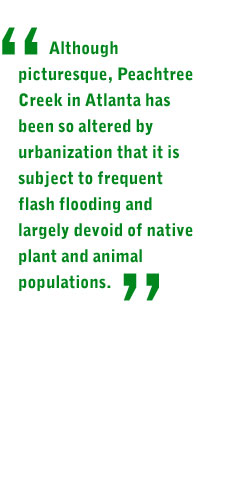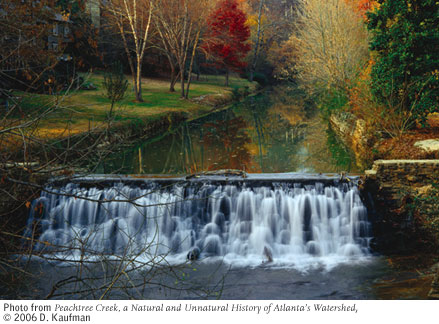


The River Doctor Is In
by Kathleen Cason
Intro
| The Urbanization of Judy
| Elements of Restoration
| Guiding Policymakers


The Elements of Restoration
Nearly four years ago, Meyer and Sudduth joined top river-systems experts from eight universities and river conservation groups to form a partnership to improve the “science and practice of river restoration.” The idea was to rigorously evaluate current practices and use research to guide future restoration efforts. The group began by compiling the first comprehensive database on nationwide river restoration projects. Now called the National River Restoration Science Synthesis database, it includes data from more than 37,000 restoration projects. Meyer and Sudduth led the effort to collect and analyze data for the Southeast.
“This database will help scientists, practitioners and policymakers think more holistically about when restoration needs to happen and help set priorities,” Meyer said.
The group reported on the state of efforts to restore U.S. streams and rivers in the April 29, 2005, issue of the journal Science. The paper identifies 13 restoration project types and their average costs based on goals such as recreation, curbing erosion of riverbanks, dam removal, habitat improvement, and storm-water management.

The scientists also identified data that needs to be reported to help guide future efforts. For example, only 58 percent of the projects listed in the database include associated costs, though the researchers conservatively estimate that about $1 billion has been spent nationwide each year on restoration projects since 1990. For the mere 10 percent of projects that monitored and assessed results, most did not evaluate the impact of restoration on the ecosystem. The authors thus recommended that restoration projects evaluate whether environmental benefits have been achieved.
In a companion article published in the April 2005 Journal of Applied Ecology, the same group outlined five criteria for measuring a restoration project’s ecological success: setting a guiding vision, measuring ecosystem improvements, causing no permanent damage during implementation, creating a sustainable ecosystem that requires minimal intervention, and conducting pre- and post-project assessments.
“Doing a large group study can put what’s going on in the Southeast into a national perspective,” Meyer said. “We can see how we’re doing.” For example, she said that 27 percent of restoration projects in the Southeast include post-project monitoring, which is better than the national average.
Most projects in Georgia are done for riparian management, water quality management, bank stabilization and channel reconfiguration. Project goals are similar in other Southeastern states, although land acquisition for stream restoration is less frequently done in Georgia than in the other Southeastern states included in the database.
Intro
| The Urbanization of Judy
| Elements of Restoration
| Guiding Policymakers
For comments or for information please e-mail: rcomm@uga.edu
To contact the webmaster please email: ovprweb@uga.edu
![]()